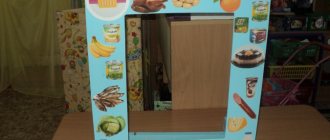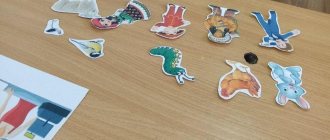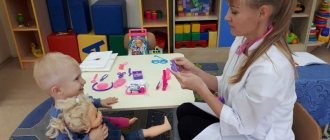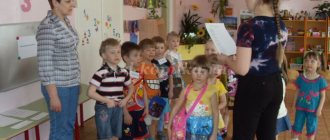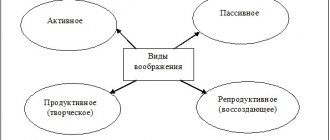Master class on making educational teaching aids for the role-playing game “Atelier”
Ekaterina Medvedeva
Master class on making educational teaching aids for the role-playing game “Atelier”
When a child masters new plots and roles , he enriches the game with new content, and then it will remain interesting for him. It is extremely important for me to maintain this interest. Therefore, I decided to create a manual for the role-playing game " Atelier "
.
Goal: production of educational teaching aids .
Objectives: to provide practical knowledge and skills in producing a manual .
To develop teachers' creative abilities .
Purpose of the manual : the manual can be used in role-playing games : “ Atelier ”
,
"Drapery"
.
This manual activates and stimulates children's sensory development .
Where to begin?
Before you start decorating a group in a kindergarten and creating various thematic corners in a kindergarten, you should definitely take care of the general decoration inside the group. When painting, you should not use a lot of bright colors. It is better if the tone of the main paint is light and “warm”:
- beige,
- peach,
- pearl and so on.
Photo wallpapers with characters from fairy tales and cartoons, as well as stickers with children's themes, look good in children's groups.
It is better to decorate all the group’s rooms in the same style and think in advance about a theme that will tie together the bedroom, reception area, study area and play corners in the kindergarten. Before you start designing specific corners, you should consult with your parents, discuss together and get acquainted with possible options for children of different ages. Here are some corners that can be organized in a kindergarten; for an example, see the photo.
Developmental environment
Play space
Traditionally, each group has a separate room for a bedroom, and the common group room is divided into an activity area and a play area. Play corners for kindergarten are designed differently depending on the age of the children in the group, free space and the creative scope of the organizer. For example, in the play area, a separate place is often allocated for a mummering corner in a kindergarten.
The location for it must be chosen with special care, it must be easily accessible and constantly open to children. The purpose of its design is to create conditions in the group for the creative activity of children, the development of imagination, the formation of gaming skills, the implementation of gaming plans, and the cultivation of friendly relationships between children. You can decorate such a place in the form of a model house, a stylist’s office, or a small screen with a variety of outfits:
- professions,
- animals,
- artists,
- fairy tale heroes and so on.
Once the location has been determined and the design option has been selected, you can begin the practical part. The boundaries of the corner are formed using furniture. This could be: a low rack with shelves, drawers and a crossbar for clothes hangers. For convenience, a table and chairs can be located in the corner. A mandatory attribute in the mummers' corner should be a mirror where children can examine and evaluate their appearance. You can paste pictures of various suits, hats and other items of clothing on the wall.
Design options
Sometimes a hairdresser’s corner in a kindergarten fits harmoniously into such a corner. Here everything is ready to equip the hairdresser’s workplace - a table, a chair for the client, a mirror. On the table you can put bottles, combs, hair decorations, etc. You can glue pictures of scissors and combs on the wall. The apron for the master can be located on one of the hangers on the crossbar.
If space allows, the hairdressing salon corner in the kindergarten is designed separately, as an independent area for the role-playing game “Barbershop”. First, the necessary furniture and shelves are also installed. Instead of a rack with outfits, you can place a bedside table or mini-wardrobe with hairdressing supplies. You can also sew wall pockets for them. Then game items are added. Usually such a place is made as a children's corner for a girl, based on an interest in hairstyles, jewelry, and so on.
Progress:
1. To prepare this manual, you must prepare:
Scraps of various types of fabric, white cardboard, scissors, paper for making templates , glue.
2. Folding a sheet of paper in half, you need to draw the outline of the intended clothing.
3. Using scissors, cut out the silhouette of the clothing to create a stencil.
4. Using a stencil, draw the silhouette of the clothing on white cardboard and cut it out.
5. Glue a piece of fabric onto another white cardboard.
6. Glue the cardboard with the cut out silhouette of the clothing onto the cardboard with the fabric.
7. Everything is ready! The product can be used!
8. You can use various stencils and fabrics.
"Mushroom Teremok" Master class on making a manual for a didactic game Good day, friends, colleagues and guests of my blog! Today I would like to present to your attention a master class on making a manual. Photo report on the master class on the production of the didactic manual “Interesting stories from pictures.” An important task in older preschool age is to prepare the child for school. Therefore, we, educators, need to teach.
Master class “Creating visual and didactic aids using ICT resources” Compiled by: Yulia Andreevna Abramova. Educator of MBDOU "D/s No. 1 Ladushki" Goal: To teach methods of mastering ICT resources. Objectives: Show.
Master class on making a didactic manual “Butterflies on a Magic Flower” (training the power of an air stream) I would like to present to you, my dear MAAM members, the author’s development of my game (I apologize in advance for the confusion in the choice of photographs). I. Master class on making a didactic manual for the musical and didactic game “Bird and Chicks” The game “Bird and Chicks” is most suitable for introducing children to high and low sounds. I used to show the children a picture, on.
For boys
However, there must be a place for boys to play in the play area. A children's corner for a boy may take up a little more space than for a girl. The main requirements for its location also remain convenience and accessibility for children. Such corners are created to take into account the gaming interests of children of different sexes, their differentiation and the development of gaming activities in general.
Design options are chosen based on the interests of the majority of boys in the group and general “boy” themes. For example:
- car showroom,
- nautical theme (ship),
- workshop,
- military base,
- or a corner of space in kindergarten.
Outer space will be interesting and useful for children of senior preschool age. With its help, children will gain basic knowledge about space, planets, and spaceships in a playful way.
The color scheme of such a corner is determined by the theme.
- blue,
- purple,
- white and yellow colors.
It would be good if the furniture for the corner was made in the same colors. If the group’s budget does not allow you to buy new furniture, you can use self-adhesive film of the desired color and texture. On the floor you can place a rug with a space theme (lunar surface, meteorite). A simple model of the solar system must be present - either as a poster on the wall, or paper planets in volumetric form, hanging from the ceiling.
Color solution
The locker room or reception area is the first thing a child and his parents see when they bring their child to kindergarten. Therefore, its design must be taken seriously. For children, there is usually a mood corner in kindergarten. The purpose of such a corner is to create a favorable emotional environment in the group. Thanks to it, children learn to understand not only their own mood, but also the mood of their peers.
In the design of such a corner, ready-made stands or home-made models can be used. The principle of their design is the same: in several pockets there are pictures with different emotions (their number depends on the age of the children), pockets for photographs of children are attached to the bottom. Coming to the group, the child, together with a parent or teacher, determines his mood and places his photo in the pocket under the corresponding emotion.
If the mood changes during the day, the photo is rearranged. Emotions can be depicted in the form of emoticons and cartoon characters. An approximate list in the older group could be: joy, fun, calm, surprise, sadness, anger.
DIY game “Atelier” for children 4–7 years old. 1 part
Elena Rozhina
DIY game “Atelier” for children 4–7 years old. 1 part
teacher knows the didactic game “ Atelier . I want to share my development. Some ideas were borrowed from others, found in the depths of the Internet, and I came up with some myself. Maybe someone will be interested in my version.
To get involved and get into the game you need a mood and atmosphere. I decided to create it first. I made a screen. I printed out pictures from the Internet and glued them onto thick cardboard that my parents brought me. It was taken from boxes with notebooks and notepads, so that they do not wrinkle, they are lined with cardboard like this. I connected two pieces of cardboard with tape. The screen is ready, quickly and inexpensively.
Then I decided to make a sewing machine. I was interested in sewing and knitting toys. I really loved, and still love, the Tilda-Mania website. That's where I took the pattern and sewed the machine.
Well, what is an atelier without mannequins ? I also sewed them, I cut them myself. Decorated. The mannequin stand is made from sushi sticks, air freshener caps, and drinking yogurt. Glued it together with a glue gun.
The atmosphere is created, attracts and interests children.
Now let's take care of the game's content. You can play in different ways . I am in the middle group, so we are still learning about different professions and getting to know the types of activities. So to get acquainted with the atelier , the work of a seamstress, a cutter, a fashion designer, we needed material. I collected it again on the Internet, printed it out and put it in files, it turned out to be a book. In it, children learn about why people come to the atelier , who works there, how the work is done, what tools they use for sewing.
To get acquainted with different types of clothing and instill aesthetic taste, I made a “Fashion Magazine”.
To get to know the fabrics, their properties and qualities, I made fabric samples. To make it easier for the children to play independently, I glued fabrics onto cardboard.
MAGAZINE Preschooler.RF
Organization of the role-playing game “Fashion House”teacher Grebneva Natalya Viktorovna MADOU Kindergarten "Childhood" JV kindergarten No. 49 "Golden Fish" Nizhny Tagil, Sverdlovsk region
Play is an intrinsic form of activity for a preschool child. The timely development of play activities and the child’s achievement of creative results in them is especially important. Learning to play is a mechanism for the teacher to naturally help the child. It includes direct interaction between the teacher and children in play, observation of children’s play, study of children’s capabilities and prospects for the development of play.
Goals:
Formation and systematization of older preschool children’s ideas about the professions of people who make clothes through plot-based role-playing play.
Creating conditions for the development of cognitive and gaming activities.
Tasks:
Educational:
- Form initial ideas that a lot of work goes into making any outfit.
- Expand and clarify children’s ideas about the professions of people who make clothes, the tools they need for work.
Educational:
- To develop in children the ability to come up with a simple plot, choose a role, and perform several interrelated actions in the game.
- To develop the ability to apply knowledge about how to operate with tools in the game, to use the attributes of a plot-role-playing game for their intended purpose.
- Develop children's creative initiative in role-playing games.
Educational:
- Develop skills of social behavior, thank for the help and care provided.
- To teach children to assign roles and act according to the role they have assumed, and to develop the plot.
Description of material:
This material can be used by kindergarten teachers with children of senior preschool age to organize role-playing games and expand children’s knowledge about the work of atelier workers.
Planned results: active use of substitute objects by children; ability to organize play space; formation of friendly relationships in the children's team.
Attributes for a role-playing game (subject-game environment):
- A variety of fabrics of different sizes and colors on display; made samples of clothes for dolls; stand with finished products; collection of fabrics (pieces of fabric of different accessories and colors); display layout with types of fabrics and accessories (can be used as a divider for the playing space); album types of fabrics.
- Sets containing multi-colored threads and buttons, sewing machines, scissors, patterns (patterns), chalk, measuring tape, cutting table, irons, ironing boards, aprons for seamstresses, a fashion magazine, mannequins.
- Mirrors (dressing table), receipts for orders, tickets and invitation cards for fashion shows, cash register, money, cameras, camera
Intended roles and game actions:
Administrator - places orders, determines deadlines for order completion, receives money for completed orders; sells tickets to fashion shows.
Studio director - hires new employees.
Fashion designer - draws sketches of clothes, selects finished products for display.
Designer - selects fabrics for clothing models, selects accessories for decorating clothes.
The cutter takes measurements and makes a pattern on the fabric.
Seamstress - sews clothes, tries on the product.
Ironer - irons, irons, steams fabrics and clothes.
Mechanic - repairs sewing machines.
Cleaning lady - removes scraps of fabric, wipes the floor in workshops, on the podium.
Promoter - distributes invitations to a fashion show.
Models learn to walk the catwalk and show fashionable clothes, demonstrate clothes at a fashion show.
Spectators (guests) at the shows take their seats, watch, applaud, and discuss clothing models among themselves.
Photographers capture interesting shots and make portfolios for models.
The driver brings fabrics from the warehouse.
Enriching the content of role-playing games:
1. Reading fiction
- Andersen G.H. "A New Outfit for the King" .
- Baranbaev Seil "Craftswoman" .
- Blaginina E. . ”
- Brothers Grimm - The Brave Little Tailor .
- Voronova L. “Masha the Confused Man” .
- Zhamanbalinov M. “You are a master - golden hands .
- Zakhoder B. “The Dressmaker” .
- Kruglyakov G. “Fashion” .
- folk tale “The clothes that anyone puts on will live a hundred years .
- folk tale "The Invisible Cap, the Magic Whip and the Seven-League Boots" .
- Nenets song "Shoemaker" .
- guessing sewing riddles from a selected card index.
- Nosov N. “Patch” .
- Pavlova N. “Whose shoes?” .
- Pierrot S. “Puss in Boots” , “Cinderella” , “Darning Needle” .
- Snegirev G. “Camel mitten” .
- Ushinsky K. “How a shirt grew in a field”
2. Conversations with children
“About professions in a fashion house” , “Fashion is interesting” , “Both girls and boys can be fashion designers” , “A fashion designer is the person who comes up with various outfits and prepares them for the show . “What is a fashion show, why is it done? ” Watch the video “Fashion show” , “Work in the studio” , etc.
3. Review
— created a fashion magazine in the group; fashion magazines "Burda" ; illustrations, pictures from the series “Professions” ; samples and types of fabrics.
4. Educational games
“Let’s dress the doll Nastya” ; “Who needs what for work” ; “Who can name the most objects” ; "Dress the doll" ; “Choose fabric” ; “Find out by description” ; “What do you need to sew a dress?; “Select by color” ; "Types of clothing" ; “Where do threads come from” ; "How to take care of your clothes" ; “What kind of fabric can you sew from?” ; “What wool do you have?” ; “Arrange your clothes according to the season” ; “Name the details of the clothing” ; "Types of clothing" ; . ”
5. Direct educational activities
- observing the work of a wardrobe maid in a kindergarten (repairing clothes), visiting the costume room of a kindergarten.
- acquaintance with the surrounding world “How a shirt grew in a field .
- studying during the GCD the presentation “What is fabric made from” , “Types of clothing” .
6. Manual labor
- applique “Dress Decoration” , “Unusual Dress” , cutting out clothes for paper dolls, making banknotes, origami wallets, price tags for fabric and clothing.
- drawing sketches of clothes, coloring, inventing clothing patterns and elements. “Let's decorate a handkerchief” , “Patterns on a dress” , “Apron for grandma”, etc..
- modeling “We decorate clothes, shoes, hats” (plasticine).
7. Excursions:
- excursion to a fabric store (familiarity with the store’s assortment (talk about the fact that there are different fabrics and different things are sewn from them; examination of threads, buttons, various additional accessories), observation of the work of the seller (how to measure and cut fabric).
- excursion to the studio (examination of the studio's furnishings and equipment, observation of the work of the studio workers (fashion designer, cutter, seamstress). Pay attention to the coherence in their work. Observation of how clients try on clothes).
- excursion to a clothing store (familiarity with various types of clothing, their sizes, appearance, additional details that decorate things and accessories).
8. Board games:
- lotto “Professions” , “Dress the doll” , “Laces” , cut-out pictures.
9. Outdoor games:
“Invisible Hat” , “Cap” , Games in the “Mumming” .
10. Interaction with parents:
- joint production or selection of attributes for the game (pieces of fabric, meter, threads, ribbons, buttons, locks, etc.)
- replenishing the mumming corner with new attributes: knitted hats for games, scarves, costumes, etc.
- a meeting with a professional, for example a mother or grandmother, a story about the professions of a sewing workshop.
- master class: . ”
- exhibition of sewn or knitted items “Handicraft” , made by the hands of mothers or grandmothers.
- exhibition "Dolls from Grandma's Chest" .
- consultation . ”
Maintaining interest in the game and developing the game's storyline:
- You can also decorate (decorate) clothes using the fabric itself (make a patch pocket, sew a belt, a bow, sew on a button).
- the atelier receives various orders for sewing clothes (from a kindergarten, school, farm, hairdresser, cafeteria, hospital, store, circus, choreography club, theater, rescue service, police, traffic police, etc.). Workers carry out orders.
- clothing demonstration (a fashion show is taking place in the city. Famous fashion designers of the city are participating in it. The fashion designer has prepared all the clothing options. A fashion show is taking place).
- Stylists and hairdressers are invited to the fashion house to create makeup and hairstyles for models.
- ordering lunches for employees from the Pizzeria .
- advertising on radio and television for the Fashion House .
- “Fabrics and Accessories” store “Fashionable Clothes” store (The seller listens to the buyer’s wishes and offers the buyer several types of fabric (clothing), measures the required yardage of fabric (selects the desired size of clothing), replies the receipt, thanks for the purchase. The buyer comes to the store to purchase the necessary fabric (clothing), selects the fabric (clothing) he likes, pays, thanks for the work, after which the buyer goes to the studio and makes his order or tries on his outfit).
- organization of exhibitions and sales of clothing.
- The storylines of the game can be different: “Call to the atelier” , “We are cutters” , “We are tailors” , “Fashion” , “We will order clothes according to the seasons” , “Opening of the atelier” , “Report about the fashion house” , “Breakage machines (iron)” , “Trying on” , “ Holiday outfits” , “The dress was torn” “The fire alarm went off” , “The lights went out” , “The required fabric ran out” , etc.
The game can be assessed by:
- children's emotional responsiveness to play; taking on the assigned role; resolving conflict situations through mutual agreement; maintaining one’s role until the end of the game action; working with the guest book.
As the game progresses, the teacher needs to become an attractive gaming partner for the child, who contributes to the development of its concept, expansion of content, clarification of game actions, roles, and the manifestation of friendly relationships.
| Next > |
Master class on making screens “Atelier”
Ekaterina Saenko
Master class on making screens “Atelier”
I bring to your attention a master class on making an “Atelier” screen for a role-playing game.
To make a screen we will need:
* Detergent bottle;
* Yogurt jar;
* Shoe box;
To design a screen for a role-playing game:
* Braid (wide, narrow, etc.);
* Various materials for didactic games;
This is the screen I made

